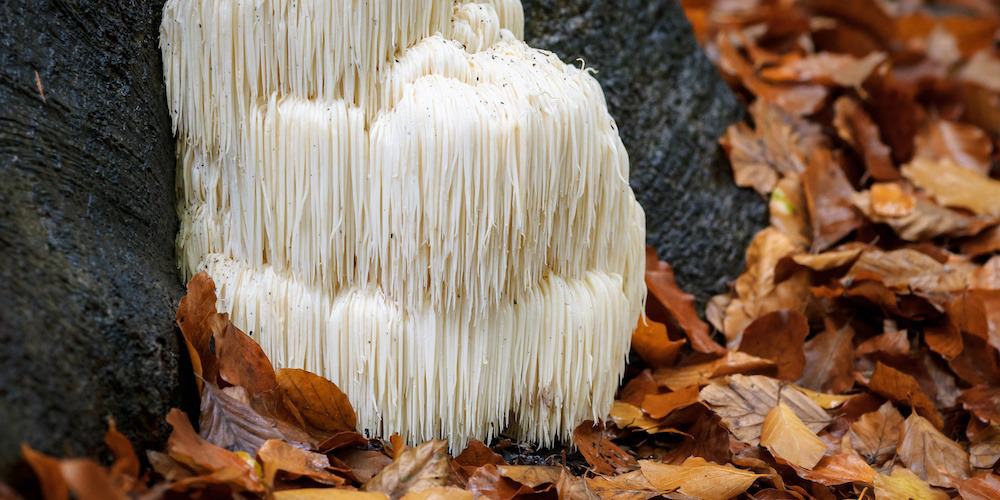BENEFITS OF LION’S MANE
✓ Relieves depressive disorders
✓ Improves cognitive functions
✓ Relieves digestive and intestinal disorders
✓ Boosts the immune system
✓ Potentially anti-cancer
What is lion’s mane?
Lion’s mane, which belongs to the Hericiaceae family, has many nicknames. It is also called “Lion’s mane” in English, “satyre’s beard,” “bearded hedgehog,” or even “monkey’s head.” It is also known as “Yamabushitake” in Japan and “Hou Tou Gu” in China. All these names refer to the same mushroom: Hericium erinaceus.
All reference its appearance. Indeed, lion’s mane has long white/cream spines measuring 4 to 6 cm that cascade downward. The whole can measure up to 25 cm wide and closely resembles a lion’s mane. This unique appearance makes it easily recognizable. In the forest, it can also be identified by its strong smell of sour milk.
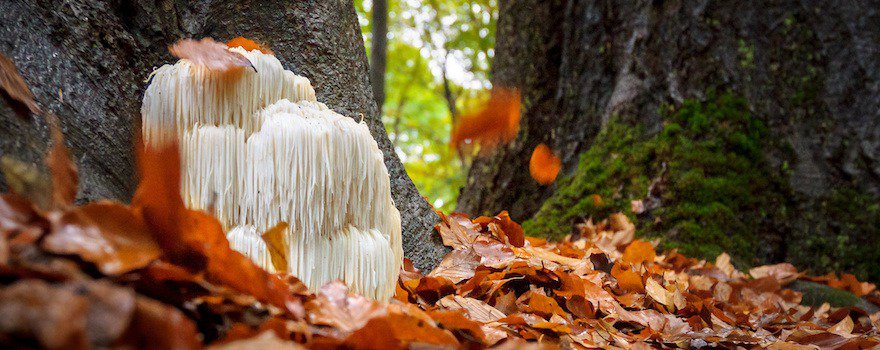
Lion’s mane naturally grows throughout Asia (China, Japan, Korea…) but also in North America (Carolina, California…) and even in Europe (Portugal, France…). It is usually found in hardwood forests and prefers deciduous trees: oaks, beeches, maples, walnuts… At the end of summer and in autumn, the mushroom grows on dead or dying trees, more rarely on living wood. It then feeds on their nutrients to develop. However, in its natural state, it remains a relatively rare mushroom.
While in the West, the consumption of lion’s mane is quite recent, the mushroom has been known in Asia for millennia. Like ginseng and reishi, lion’s mane is mentioned in very ancient Chinese traditional medicine treatises.
It notably appears in the “Shennong bencao jing” (372-288 BC) where it is indicated for relieving digestive disorders and improving cognitive functions.
Scientific research has then contributed to the worldwide popularity of lion’s mane. Gradually, the incredible composition of this mushroom and its beneficial effects on the body have been discovered. Today, studies primarily focus on its antidepressant effects.
Also read This startup will make you love functional mushrooms
But this mushroom is also interesting for improving cognitive functions, relieving digestive and intestinal disorders, and boosting the immune system. It also shows promising results in the fight against cancer. It is thus considered a functional mushroom, meaning that beyond its nutritional properties, it has real effects on the body.
Nutritional Composition
- Amino acids including the 8 essential ones
- Vitamins: B2
- Minerals and trace elements: zinc, phosphorus, selenium, iron, potassium, germanium
- Proteins
- Polysaccharides: beta-glucans
- Other active compounds: D-arabinitol, D-Thréitol
- Phenolic derivatives: erinacines, hericenones
- Fatty acids: palmitic acid
- Sterols: ergosterol, beta-sitosterol
- Fibers
- Lectins
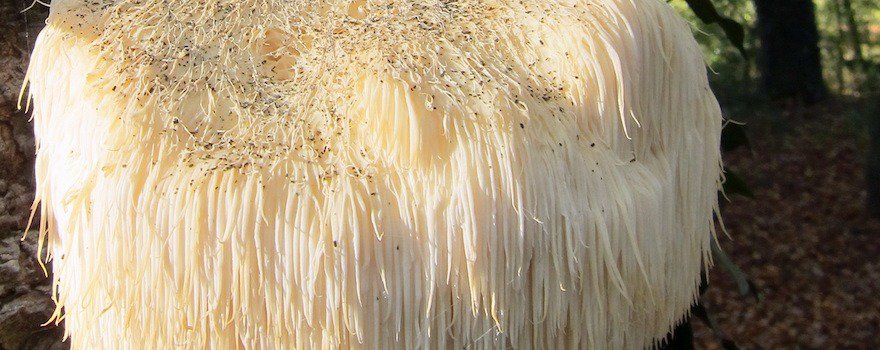
The benefits of lion’s mane
🧘🏻♀️ Relieves depressive disorders
Lion’s mane is a valuable ally for the nervous system. It has particularly shown to be interesting for relieving depressive disorders and associated symptoms: loss of interest, difficulty concentrating, fatigue, sleep disturbances, pessimism…
These effects are due to certain compounds present in lion’s mane such as erinacines and hericenones. Indeed, these phenolic derivatives have the ability to stimulate the synthesis of NGF (Neuronal Growth Factor) or nerve growth factor. Responsible for the development of new neurons, it is also involved in depression.
Moreover, these compounds act beneficially on BDNF (Brain-Derived Neurotrophic Factor) levels, which when too low, are associated with depression. Researchers now want to verify if the erinacines and hericenones of the mushroom can restore BDNF levels in people with depression.
This mushroom can also relieve depression by exerting anti-inflammatory effects. Indeed, depression can be directly associated with inflammation. The inflammatory process disrupts brain function and alters the release of neurotransmitters essential for mood regulation, such as dopamine and serotonin.
Its compounds can also reduce depressive behaviors by promoting neurogenesis, that is to say, the formation of new neurons in the hippocampus. It is known that hippocampal volume loss is more significant in the case of depression. By limiting neurogenesis deficiency, lion’s mane contributes to reducing the frequency and severity of depressive episodes.
Finally, lion’s mane can exert an anxiolytic effect by relieving anxiety and distress.
This study from the University of Hong Kong, conducted on mice, highlights the therapeutic potential of lion’s mane in alleviating depressive disorders.
This other study from the University of Pisa (Italy), conducted on rodents, focused on the antidepressant effects of lion’s mane and rhodiola (Rhodiola rosea).
👩🏻🏫 Improves Cognitive Functions
Lion’s mane is a particularly effective mushroom for enhancing cognitive functions: concentration and memory, attention, learning… Therefore, its consumption could be indicated in the treatment of neurodegenerative diseases such as Alzheimer’s disease.
By stimulating the production of new neurons, hericenones and erinacine contribute to nerve regeneration and limit the progressive loss of neurons. Additionally, the polysaccharides present in the mushroom also play an important role in improving cognitive functions.
On one hand, they reduce the abnormal accumulation of β-amyloid plaques (Aβ) that occur in Alzheimer’s disease and are responsible for cognitive losses. On the other hand, the polysaccharides exert neuroprotective effects against free radicals, which cause neuronal damage.
This study from Jilin University (China), conducted on mice, demonstrates lion’s mane’s neuroprotective properties.
This other study from National Yang-Ming University (Taiwan), conducted on mice, shows the potential of the mushroom in treating Alzheimer’s disease.
♻️ Relieves Digestive and Intestinal Disorders
Lion’s mane is not only an ally for the brain: it is also a friend of the stomach and the intestinal sphere.
It is primarily interesting for protecting stomach mucous membranes against certain bacteria including Helicobacter pylori, responsible for gastritis and ulcers. To eradicate it, the mushroom can rely on its antibacterial activity. This is indeed one of its main indications in traditional Chinese medicine. Lion’s mane significantly inhibits bacterial growth, reduces stomach inflammation, and contributes to the reconstruction of gastric mucosa.
Its consumption can also help relieve inflammatory bowel diseases: ulcerative colitis, Crohn’s disease…
This study from the Shanghai Academy of Agricultural Sciences (China), conducted on a human cell line, demonstrates the anti-Helicobacter pylori activity of lion’s mane.
This other study from the University of Georgia (United States), conducted on mice, shows how the mushroom inhibited the growth of the Helicobacter pylori bacterium.
🛡Boosts the Immune System
Lion’s mane is an excellent immune stimulant. It activates the body’s natural defenses against pathogens and prevents their damage.
The mushroom notably stimulates the activity of T cells and NK cells, the Natural Killer Cells. To do so, it acts directly on the intestinal microbiota, which plays an essential role in supporting immunity. The polysaccharides and HEP3, one of the beta-glucans in lion’s mane, are thought to be responsible for this immunostimulant activity.
Moreover, D-threitol, D-arabitol, and palmitic acid contained in the mushroom have antioxidant properties.
This study from the Guangdong Microbiology Institute (China), conducted on mice, shows how lion’s mane boosts immunity via the intestinal microbiota.
This other study from Northeast Normal University in China, conducted on mice, demonstrated the beneficial effects of the mushroom on intestinal mucosal immunity.
🔬 Potentially anti-cancer
Some studies dedicated to the Lion’s Mane have highlighted its anti-cancer potential, particularly against liver, colon, stomach, and blood cancer.
On one hand, the mushroom’s beta-glucans directly attack cancer cells and induce apoptosis, which is programmed cell death. On the other hand, they significantly slow their growth and thus the spread of cancer.
This study from the Changchun University of Chinese Medicine (China), conducted on precancerous cells, shows how the Lion’s Mane induced their apoptosis.
This other study from Shanxi Agricultural University (China), conducted on cells, demonstrates that the mushroom’s polysaccharides inhibit the growth of colon cancer cells.

How to consume the Lion’s Mane?
The Lion’s Mane in tablets
After harvest, the Lion’s Mane is dried and then ground into powder. The powder is then used to manufacture tablets and capsules, easily found in stores or online. If you are concerned about its pronounced taste (between lobster and eggplant), choose this format which has the advantage of being tasteless.
To maximize the benefits of the mushroom, choose tablets and capsules sufficiently titrated in polysaccharides (minimum 30%).
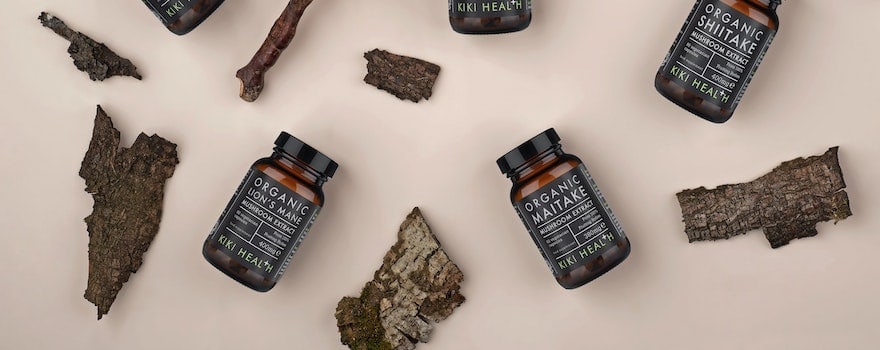
The Lion’s Mane in powder
It is also possible to find Lion’s Mane in powder. The mushroom is simply dried, ground, and then marketed. If its taste doesn’t bother you, it’s an interesting format because it’s convenient to consume.
Lion’s Mane powder mixes easily in hot water, milk, fruit juice, soups, and broths.
The Lion’s Mane in mother tincture
The mother tincture of Lion’s Mane is obtained by double extraction. It mixes easily in water or any other beverage.
But it’s a format harder to find and has the disadvantage of containing a lot of alcohol. It is therefore not recommended for pregnant women, children, or people with certain conditions.
The dried Lion’s Mane
Some online shops offer dried Lion’s Mane cut into slices. It is a very good edible mushroom that can be integrated into broths or soups. It is also a common ingredient in Chinese and Japanese cuisine.
Lion’s Mane and medicinal plants
The Lion’s Mane goes very well with medicinal plants that are good for the brain. Among them, we can mention ginkgo biloba, rhodiola, and bacopa (Bacopa monnieri).
It can also be consumed in combination with cordyceps (Ophiocordyceps sinensis), another mushroom that helps with nervous balance.
Also complement your consumption of Lion’s Mane with intakes of vitamin B (B1, B2, B3, B5, B6, and B9) that contribute to the proper functioning of the nervous system.
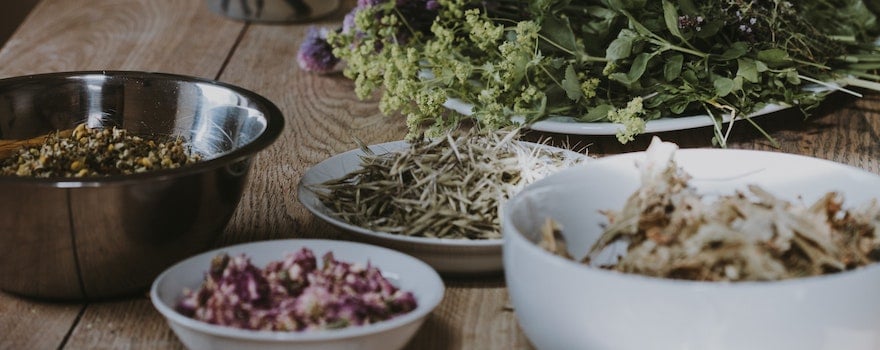
Consume sustainably: prioritize organic, fair trade, and local Lion’s Mane
✓ Like all mushrooms, the Lion’s Mane tends to absorb pollutants present in the air and soil. This is why we advise you to choose a certified organic mushroom, cultivated without chemicals and away from pollution sources. It must also be guaranteed GMO-free and non-irradiated.
✓ Today, most production comes from Asia. But France also has some mushroom farms that have started cultivating the Lion’s Mane. It is then developed on substrates of sorghum, rye, or wheat. If possible, choose a mushroom of French origin.
✓ Finally, to avoid encouraging intensive wild harvests, prioritize fair trade channels or small businesses.
Dosage
⚖️The recommended dosage ranges between 500 mg and 1.5 g of Lion’s Mane per day. Since it is a potent mushroom, we recommend starting with small doses. Then gradually increase your consumption based on the effects felt.
⏳The ideal is to take it in the form of a cure from 1 to 4 months. Preliminary results appear after a few weeks.
Consume the mushroom before or after meals.
💊In tablets : up to 3 per day for capsules of 250 mg.
🥄In powder form : 1 to 2 teaspoons per day.
🧪In mother tincture : 1 teaspoon, 2 times a day.
Contraindications and side effects
The consumption of lion’s mane has some contraindications:
- As a precaution, young children, pregnant or breastfeeding women should avoid taking it.
- People suffering from fibromyalgia, interstitial cystitis, polycystic ovaries, or having a high NGF level should also avoid consuming it.
- Because it may affect blood coagulation, it is not recommended for people undergoing surgery.
- Its consumption is not recommended for allergic individuals or those sensitive to mushrooms.
Excessive consumption of lion’s mane may lead to the following side effects:
- Itching
- Allergies (breathing difficulties, skin rashes)
If you experience side effects, stop consumption and consult a doctor.
History, culture, and market of lion’s mane
According to the IUCN Red List (International Union for Conservation of Nature), the global population of lion’s mane is declining significantly. The species is even protected in some countries and conservation measures are in place.
Several threats are currently facing this mushroom. Among them: destruction of its natural habitat through the felling of old oaks and beeches, elimination of dead wood, forestry activities, agricultural expansion, and intensive harvesting. It is therefore more than ever a rare mushroom to protect. One of the ways to consume it sustainably is to obtain extracts from mushroom farms.
Report by Julia Perez and Charlotte Jean
Sources and scientific studies
Pit Shan Chong, Man-Lung Fung, Kah Hui Wong, and Lee Wei Lim, 2019. Therapeutic Potential of Hericium erinaceus for Depressive Disorder.
Fiona Limanaqi, Francesca Biagioni, Carla Letizia Busceti, Maico Polzella, Cinzia Fabrizi, Francesco Fornai, 2020. Potential Antidepressant Effects of Scutellaria baicalensis, Hericium erinaceus and Rhodiola rosea.
Junrong Zhang, Shengshu An, Wenji Hu, Meiyu Teng, Xue Wang, Yidi Qu, Yang Liu, Ye Yuan, Di Wang, 2016. The Neuroprotective Properties of Hericium Erinaceus in Glutamate-Damaged Differentiated PC12 Cells and an Alzheimer’s Disease Mouse Model.
Tzeng Tsai-Teng, Chen Chin-Chu, Lee Li-Ya, Chen Wan-Ping, Lu Chung-Kuang, Shen Chien-Chang, Huang F Chi-Ying, Chen Chien-Chih, Young-Ji Shiao, 2016. Erinacine A-enriched Hericium Erinaceus Mycelium Ameliorates Alzheimer’s Disease-Related Pathologies in APPswe/PS1dE9 Transgenic Mice.
Jian-Hui Liu, Liang Li, Xiao-Dong Shang, Jun-Ling Zhang, Qi Tan, 2016. Anti-Helicobacter Pylori Activity of Bioactive Components Isolated From Hericium Erinaceus.
Ge Wang, Xiumin Zhang, Susan E Maier, Liping Zhang, Robert J Maier, 2019. In Vitro and In Vivo Inhibition of Helicobacter Pylori by Ethanolic Extracts of Lion’s Mane Medicinal Mushroom, Hericium Erinaceus (Agaricomycetes).
Chen Diling, Zheng Chaoqun, Yang Jian, Li Jian, Su Jiyan, Xie Yizhen, Lai Guoxiao, 2017. Immunomodulatory Activities of a Fungal Protein Extracted From Hericium erinaceus Through Regulating the Gut Microbiota.
Xiaotong Sheng, Jingmin Yan, Yue Meng, Yuying Kang, Zhen Han, Guihua Tai, Yifa Zhou, Hairong Cheng, 2017. Immunomodulatory Effects of Hericium Erinaceus Derived Polysaccharides Are Mediated by Intestinal Immunology.
Mingxing Wang, Yanqiu Zhang, Xulang Xiao, Duoduo Xu, Yang Gao, Qipin Gao, 2017. A Polysaccharide Isolated From Mycelia of the Lion’s Mane Medicinal Mushroom Hericium Erinaceus (Agaricomycetes) Induced Apoptosis in Precancerous Human Gastric Cells.
Jing-Yu Liu, Xiao-Xiao Hou, Zhuo-Yu Li, Shu-Hua Shan, Ming-Chang Chang, Cui-Ping Feng, Yin Wei, 2020. Isolation and Structural Characterization of a Novel Polysaccharide From Hericium Erinaceus Fruiting Bodies and Its Arrest of Cell Cycle at S-phage in Colon Cancer Cells.
Kałucka, I.L. & Olariaga Ibarguren, I. 2019. Hericium erinaceus. The IUCN Red List of Threatened Species 2019.


